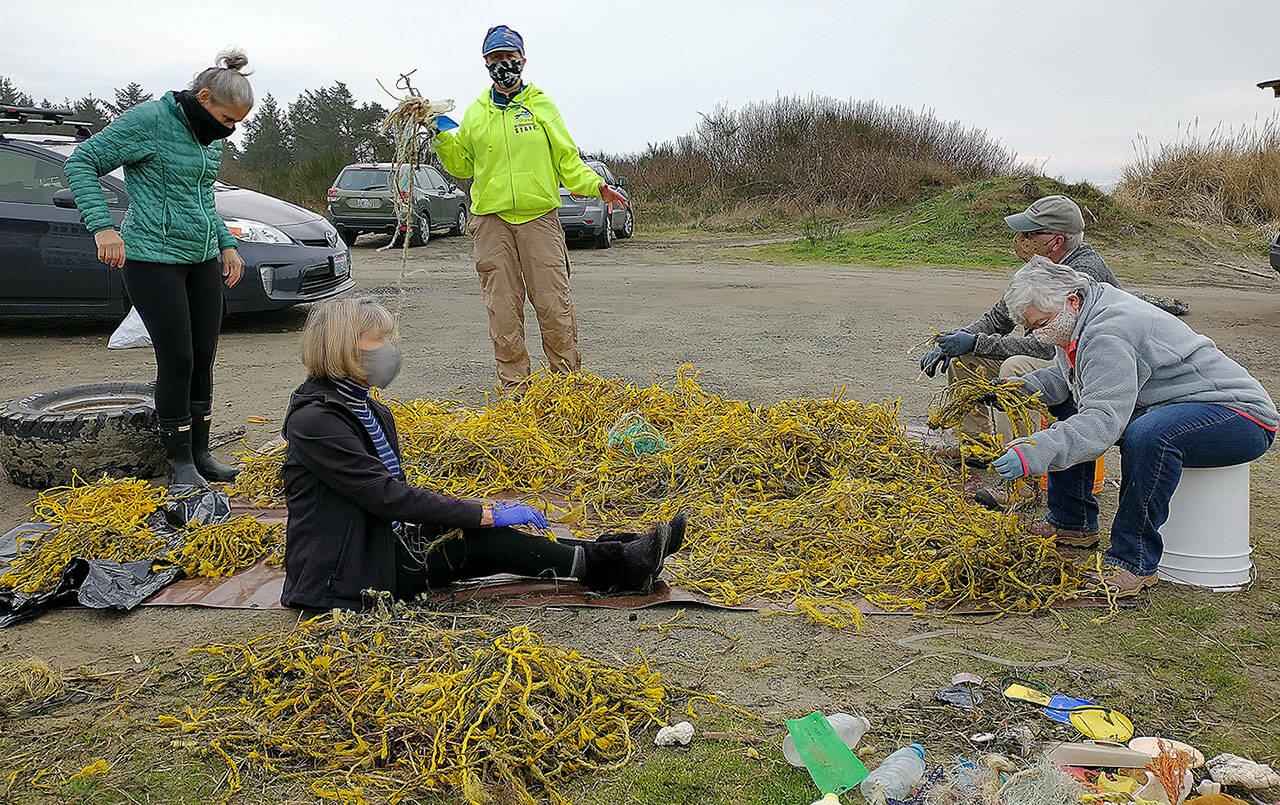Locals and volunteers from Twin Harbors Waterkeeper and Surfrider Foundation coordinated a series of beach cleanups last year to collect marine debris and yellow ropes. From late fall 2020 to spring of 2021, almost 87,000 yellow ropes were collected from the Southwest Washington coast.
“Although most ropes were collected between Tokeland and Westport, some were found as far north as Olympic National Park beaches,” said Twin Harbors Waterkeeper Lee First. “This fall to spring we are hoping that the number of yellow ropes collected is less than last season as legacy ropes are removed and new practices are implemented.”
The efforts of two Grayland volunteers, Lynne and Brian Kelly, are especially noteworthy. Over a period of several years, they collected more than 50,000 yellow ropes during their beach walks, and brought this issue to the forefront. They counted the ropes, collected them in sacks, and stored them in their garage for over a year.
Waterkeeper and Surfrider will host three marine debris cleanups to coincide with upcoming king tides. The cleanups will occur on multiple beaches on Nov. 20, Dec. 18, and Jan. 15, 2022.
“I love beach cleanups. They’re a great way to get outside and meet like-minded people and improve the health of our beaches,” said Liz Schotman, Surfrider Foundation western regional manager.
Three strand yellow polypropylene rope has been used for over 50 years by area oyster farmers using the long line method: a “mother oyster” is woven into the rope, and the ropes are strung out between metal posts for two years. Oyster spat collects and grows on the ropes.
At harvest time, clusters of marketable sized oysters are attached to the ropes. In many cases, once the oysters are shucked, pieces of rope still present in shell piles get distributed back into the tide flats for other oyster growing methods. The yellow ropes eventually break free.
Plastic does not decompose — it photodegrades, breaking into tiny fragments called microplastic. Yellow ropes contain three strands, each of which contains over 20 single strands. Ocean currents and waves cause the ropes to fray, breaking them down into microplastics. These tiny fragments last for hundreds of years, and can enter the food chain.
“We have seen yellow rope on the south beaches for years, knew they were related to the oyster industry, but no one was sure just how they came to be on the beaches,” said Westport-South Beach Historical Society Director John Shaw. “In late 2019 we asked the industry to meet with us at the Maritime Museum and a great collaboration started, first to identify, then soon after cleanups and work to change practices began.”
Within the last week or so, Shaw said he’s seen a drastic reduction in the amount of yellow rope that usually accompanies the high tides of October.
Many others assist with cleanup efforts. The efforts of the Pacific Shellfish Company included 103 cleanups between their three farms in Grays Harbor and Willapa Bay.
“At each cleanup, an average of between four to five people worked 4-5 hours including transportation time,” said Kyle Deerkop, Pacific Seafood Grays Harbor farm manager. “Most efforts have been focused between Tokeland and Westport. Staff has been paid and as a bright spot we have been able to employ some local high school kids to help with the effort.”
Area oyster growers are taking steps to prevent the discharge of yellow ropes, including but not limited to removing ropes from legacy shell piles to ensure they don’t remain attached to shells that are distributed back to the tide flats.
“We have also begun construction on a mobile crushing unit that will be shared with other industry members to address legacy rope in older shell piles,” said Deerkop. “This has all come at a cost, but we are an invested stakeholder and believe that it is important to do the right thing both now and in the future.”
The Willapa-Grays Harbor Oyster Growers Association (WGHOGA), the Pacific Shellfish Growers Association (PCSGA), State Parks and Grays Harbor Solid Waste Department also assisted with cleanup efforts by providing staff and waste hauling services.
“WGHOGA and PCSGA are committed to hosting our yearly beach cleanup efforts in early spring each year and dumpsters will be made available to provide convenient disposal of all marine debris encountered,” said David Beugli, WGHOGA executive director.
First said all 88,000 yellow ropes have been transported to a mechanical recycling facility in British Columbia where they’ll be ground into pellets and used to manufacture crab calipers.
“I’m also excited that we’ll be upcycling the rope into useful products instead of just sending them to the landfill,” said Schotman.
Join volunteers on Nov. 20 at 9 a.m. in Grayland for marine debris and yellow rope cleanup. Bring your bags, gloves and boots and choose a start point — Smith Anderson Road, Sea Mobile Road, Short Beach or Warrenton Cannery Road. Once you are all tuckered out or maxed your bags with debris, bring them to the Warrenton Cannery Road terminus.
Social distancing will be practiced and masks and gloves are required. Cleanups will also be held at the same locations on Dec. 18 at 9 a.m. and Jan. 15, 2022, at 11 a.m.


